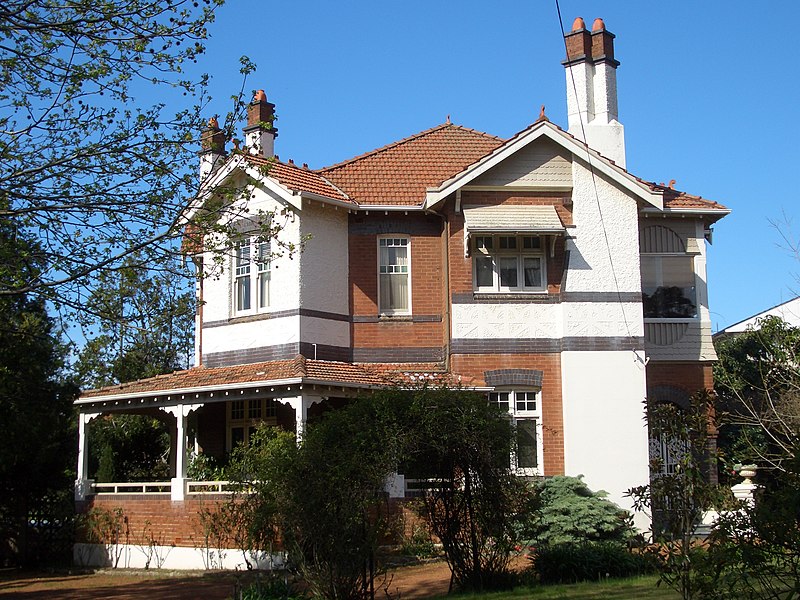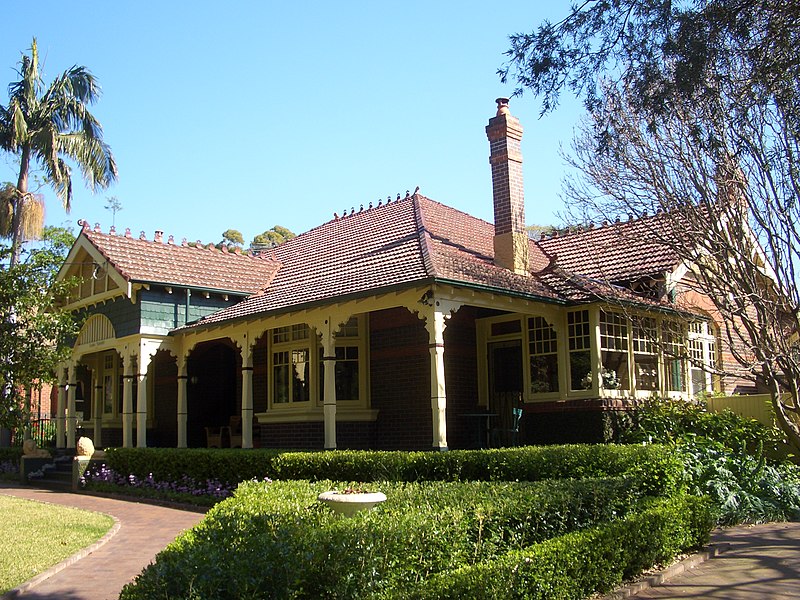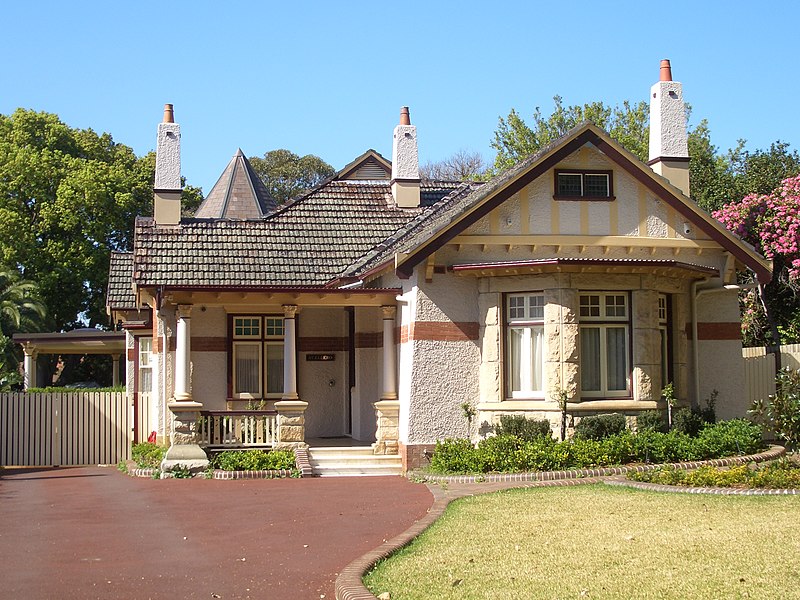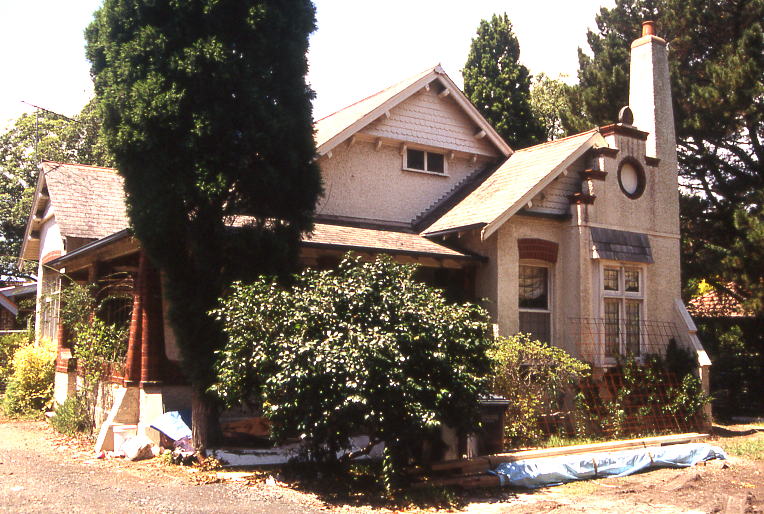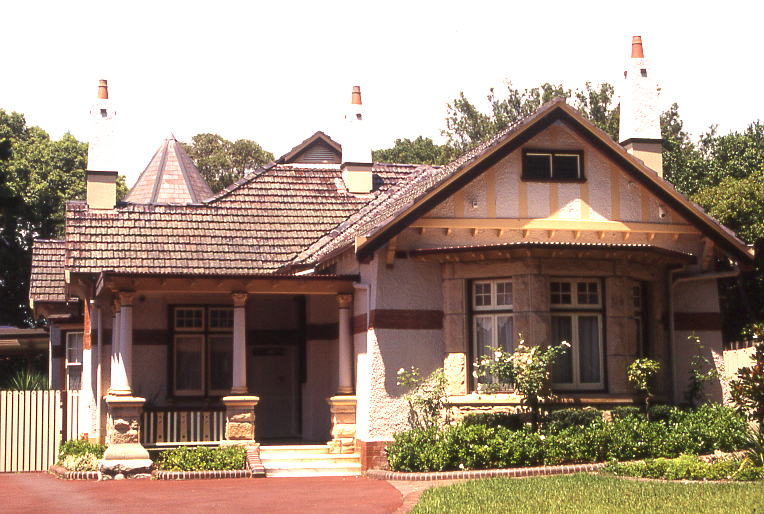BECKY BARKER May 8, 2010 Sydney Morning Herald
[Previous page:
Books about Federation Housing Architecture Next Page:
Kianga: Vaucluse Federation House ]
 |
| An example of a Federation era house. |
'People love old houses' say architect Clive Lucas
Becky Barker seeks advice on whether reviving historic houses is really worth it.
If you believe the hype on TV renovation shows, it seems anyone can make a million by restoring an old building. But does it pay to buy a piece of Australian history and restore it with period precision?
The general manager of property valuer Herron Todd White, Michael McNamara, is not convinced. At a recent auction of an authentically restored Victorian semi in Sydney's inner west, crowds flocked to view the house but no one bid for it.
 |
| The facade of the carefully restored 1894 Queen-Anne style home |
Click for more photos
A labour of love
The facade of the carefully restored 1894 Queen-Anne style home
"Some people go too far," he says. "There were beautifully restored ceilings, big original skirting boards and cornices. It was like walking through a museum. It's probably one of the greatest myths that you can buy an old house and make money by restoring it to the glories of yesteryear."
But despite the prospect of poor rewards or even bankruptcy, hundreds of people embark on heritage renovations every year. Last year, Woollahra Council received 91 applications to alter homes with heritage significance in Paddington, Woollahra and Watsons Bay alone. Heritage architects say buyers adore these character charmers.
"People love old houses," says architect Clive Lucas, of Clive Lucas, Stapleton and Partners. "Some want to live in a museum environment - they collect furniture and antiques and want a setting that suits."
Having worked on the restoration of Old Government House in Parramatta, Australia's oldest intact Georgian mansion, he understands the detective work required to achieve an authentic result.
"We scrape back old wallpaper and woodwork to find original colours," he says.
"Some councils will ask for colour schemes but this can be a bit premature when you have to do the work first to find out what was there in the first place."
Such large projects are rare but there are plenty of rich pickings available for the first-time restorer. McGrath Inner West agent Simon Pilcher says if you can buy a period property for a good price in an up-and-coming area, it can be personally and financially rewarding. In March, he sold a Victorian terrace in Newtown, bought for $1 million about three years ago, for $1.275 million. It had undergone a minor makeover including polishing floorboards, repainting and installing new carpets. "Sellers can make around 20 to 30 per cent more if they sell well-renovated older-style properties," Pilcher says.
And David Boddam Whetham, of Boddam Whetham architects, says extra funds are available. "Councils offer grants of up to $10,000 to certain [heritage] projects," he says.
But Pilcher's colleague, Michael Glynn, cautions: "Councils are principally concerned about retaining facades and rooflines. "Don't try to fake it."
Nailing it: How to achieve the look of Australia's principal architectural styles
Colonial 1788-1840
Characteristics
Usually simple single-storey. Large front verandah which may run around house.
Twelve-paned double hung windows on either side of a central front door, often with arched fanlight above.
Door sometimes flanked by two or more pillars.
Get the look
Try to use second-hand sandstone brick with flecks of black and grey. Most roofs are pitched corrugated iron but traditionally they were made from timber shingles, slate or imported iron tiles. Timber floors and lime-washed walls throughout.
Victorian terrace 1840-1890
Characteristics
Narrow, single or two-storey, painted, cement-rendered façade, small front verandah and balcony with upper-level french doors to iron balustrade. Steeply pitched slate or corrugated iron roof, often hidden behind parapet. Prominent chimney.
Get the look
Use existing features to help source decorative lace ironwork (avoid cheap reproductions) and traditional patterned tessellated porch tiles. Repair or reinstate rectangular fanlight above front door. Render brick to look like stone. Paint door dark green or red. Black came later.
Victorian weatherboard cottage 1840-1890
Characteristics
Simple and modest, single-storey design.
Corrugated iron roof, timber boards and timber or cast iron verandah posts on porch. Lace balustrade.
Prominent pitched roof.
Get the look
Imitate similar properties in the area. Use materials to match existing features, such as authentic timber boards. Ensure adequate under-floor ventilation.
Remove later additions such as aluminium windows, replace with traditionally sized timber ones. Avoid high fences and carports out front.
Federation 1890-1915
Characteristics
Single and double storey, front verandah with decorative timber handrails and turned timber pillars. Porch and entrance hall tiling. Usually built of deep red or dark brown brick or a mix of both. Terracotta tile roof, multiple gables and exterior motifs. Leadlight windows.
Get the look
Try to match original building materials with regards to tiles, floorboards and bricks. Retain and restore sought-after original features such as high ceilings and ceiling roses.

Federation house in Queen Anne style, without prominent chimneys.

The lounge room of Patricia Bradley's lovingly restored Federation house.

Bay window in Victorian arch. Original upper panes would be coloured glass

The ceiling rose, suspended lighting as lamp covers, and highly decorated ceiling in the Victorian style

Bay window as a 'nook' for reading or hobby craft, wooden decoration is typically Federation

Frieze and Victorian decoration, not typical of Federation style

Patricia Bradley’s 20-year quest to restore her home, and its facade, to its former glory has proved a major success.

Bay window shows original coloured glass typical of the period
Arts & crafts 1910-1920
Characteristics
Romantic, cottage-type feel and simplicity.
Set in grounds of rambling garden, asymmetrical and informal shape.
Fanciful features include bay windows, motifs, carved posts, leadlight windows and clay tile or slate roof with ornamental brackets, corbels and tall chimneys.
Get the look
Aim for rendered stucco, pebble, brick walls and stone bases. Shingles were also incorporated. Employ a skilled carpenter as the hand-made look typifies the style. Create an attractive garden to complement.
Californian bungalow 1915-1940s
Characteristics
Sturdy appearance, single storey with a two to three-gabled, low-pitched roof, terracotta roof tiles and large pillars supporting a front verandah. Stained glass windows, decorative ceilings, painted gables with battens or shingles.
Get the look
Dark brick exterior with sandstone, face brick, painted render and pebbledash on columns. Though traditionally painted dark colours, lighter colours are now more fashionable and brighten the façade.



























